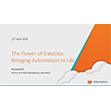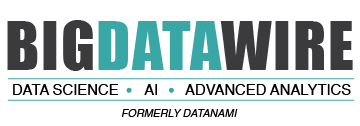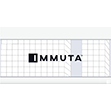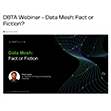
The End of the Data Broker Model and the Rise of the Data Marketplace

(PopTika/Shutterstock)
Most commodity markets have evolved from traditional broker models to more transparent, efficient transactions with lower fees and higher impact for both buyers and sellers. Travel agents, stock brokers, and even real estate agents (to name just a few) have been either completely replaced or greatly disrupted by digital marketplaces. Gone are the days of paying brokers high fixed or percentage fees for the straightforward tasks of connecting buyers and sellers to transact on largely standardized products or commodities.
Take for example the changes made in financial services: the rapid growth of passively managed, low fee Exchange Traded Funds (ETFs) vs. the more traditional actively managed mutual fund, with fund managers acting as intermediaries in the construction and management of the fund’s underlying assets.
I have seen this transition in digital advertising as well – the rise and decline of digital advertising networks. As with other ad markets, digital networks delivered scale, performance optimization, and rudimentary quality controls to digital ad buyers with non-transparent percentage fees on advertising spend. As ad formats commoditized, ad buyers found not just scale, but dramatically more transparency, quality control, and lower, more transparent fees through ad exchanges. The digital networks that captured the lion’s share of billions in digital ad spend outside of Google and Facebook in 2015 are essentially gone five years later.
This same phenomenon is now underway for buyers and sellers of data assets, and not just for martech and advertising use cases. According to the latest report by The Eckerson Group, The Rise of the Data Exchanges:
“Data exchanges are emerging as a key component of the data economy. By connecting data suppliers and consumers through a seamless experience, data exchanges have created a modern-day goldrush to help modern, digital organizations address their insatiable hunger for data. And, by eliminating the friction from finding, acquiring, and integrating data, these exchanges make it easy for any company to monetize its data assets and create new revenue streams.”
The rise of these data exchanges or marketplaces, and the decline of the broker model for data will benefit not just buyers and sellers, but more importantly, consumers that own the data they create through their digital interactions.
Before outlining the specific problems with the broker model, it’s important to ask what the key drivers are for buyers and sellers; how do most data transactions work today? Most transactions are managed by an intermediary broker through a process like this:
1) Broker asks the buyer what they are trying to achieve, e.g. better personalize an app experience, estimate the future value of a customer, understand store location visitation patterns, improve the relevance of an ad
2) Broker aggregates data assets (e.g. location data, mobile device IDs related to app installs, behavioral data derived from browsing behaviors of mobile app IDs) from a few sellers
3) Broker delivers that aggregated snapshot back to the buyer mapped to a list of emails, mobile IDs, geo locations, or similar
This method of transacting has several challenges for buyers and sellers, each of which are addressable if you fast forward beyond the data broker model.
Problem #1: Speed. Almost all the problems buyers are looking to solve are ongoing problems. Data assembled as a snapshot is stale the day after it’s delivered, and erodes quickly from then on. If you want to continue to personalize your app, you need current data all the time.
Solution: A robust data marketplace automatically manages updates to underlying data so the buyer has effectively “always on” access to the latest and greatest. There should be no need to rerun queries, normalization, etc. every time you refresh. The additional upside is that as soon as the time is cut down between the buying and selling of data there no longer is the opportunity cost that is associated with time. That opens up the ability to test, play, experiment, and change strategies as the business warrants.
Problem #2: Quality. Accuracy, completeness, recency, is generally opaque to the buyer. The buyer does not know what she’s getting even after she gets it. If the downstream results of the exercise are poor due to any of those quality issues she’ll have a hard time figuring that out, perhaps assuming the exercise had limited potential ROI based on the results.
Solution: An effective data marketplace or exchange scores the quality of underlying data assets to make critical quality attributes like accuracy and recency transparent to the buyer along with the identity of the sellers.
Problem #3: Discovery. In the broker model, buyers rely on the intermediary to find the right data on their behalf, without understanding the comprehensive catalog of what data sellers and solutions may be available. What may be “good enough” from the broker’s perspective this translates to missed opportunities for both buyers and sellers.
Solution: A true data marketplace enables buyers to easily and transparently search and browse the universe of data products that may help them improve results for their use case.
Problem #4: Non-transparent economics. Data brokers may charge arbitrary and/or high fees that obscure the underlying economics to both buyer and seller. This limits the potential value for both buyer and seller, which limits the overall potential for the marketplace.
Solution: An efficient data marketplace charges reasonable, transparent fees, and only for the data the buyer truly wants to buy. The buyer chooses the most promising data for their current application, for economics that are transparent and repeatable.
Problem #5: Compliance. Brokers have limited tools and incentives to help sellers and buyers understand source data compliance with applicable privacy and other regulatory issues, particularly as policies and regulations evolve over time. This is a huge problem for consumers. Any given data source may have unknown compliance, or worse yet, be out of compliance with critical consumer privacy protections. Consumers lose transparency and control over their data with no way to get it back.
Solution: a privacy-centric data marketplace not only promotes consumer choice and transparency with features like central opt outs, it enables all participants to track policies as they change over time, and automatically flags any data that has an unknown state of compliance.
Beyond the critical improvements needed for consumer privacy protection, the downstream effect of the problems together is the negative impact on buyer ROI. One-off transactions with low quality, potentially non-compliant data on top of unclear underlying economics means most broker managed transactions are unprofitable. Consumers do not get the more personalized app experience, the more relevant content or ad that the data buyer was trying to achieve. How much more is the buyer going to invest in these transactions?
By addressing these problems, a data marketplace or exchange that replaces brokers delivers better ROI for buyers, more demand for sellers, and better outcomes for consumers along with the critical improvements to transparency and choice mentioned above. As a board member for a company involved in creating data marketplaces, I’ve had the first-hand opportunity to see how an effective data marketplace can function and deliver these benefits for all participants in the marketplace.
Data brokers are going the way of travel agents. They’ll be around for a few more years, but if you’re looking for sustained results you’re much better off using a marketplace that delivers quality data quickly, transparently, and with verifiable protection for consumers’ privacy.
About the author:  Ryan Christensen is a tech executive with 25 years of experience in enterprise, advertising, and marketplace technology businesses. Ryan was most recently SVP of Platform Product at Xandr (AT&T) after serving as the COO of AppNexus, which was acquired by AT&T in 2018. He currently sits on the Board of Narrative.io, a software company simplifying the acquisition and distribution of data. He can be reached on Twitter via @r_y_a_n_c and at https://www.linkedin.com/in/ryanechristensen/.
Ryan Christensen is a tech executive with 25 years of experience in enterprise, advertising, and marketplace technology businesses. Ryan was most recently SVP of Platform Product at Xandr (AT&T) after serving as the COO of AppNexus, which was acquired by AT&T in 2018. He currently sits on the Board of Narrative.io, a software company simplifying the acquisition and distribution of data. He can be reached on Twitter via @r_y_a_n_c and at https://www.linkedin.com/in/ryanechristensen/.
Related Items:
Taking the Pain Out of Buying and Selling Data
Easy Money? Considerations for Building Out Your Data Monetization Practice
April 25, 2025
- Denodo Supports Real-Time Data Integration for Hospital Sant Joan de Déu Barcelona
- Redwood Expands Automation Platform with Introduction of Redwood Insights
- Datatonic Announces Acquisition of Syntio to Expand Global Services and Delivery Capabilities
April 24, 2025
- Dataiku Expands Platform with Tools to Build, Govern, and Monitor AI Agents at Scale
- Indicium Launches IndiMesh to Streamline Enterprise AI and Data Systems
- StorONE and Phison Unveil Storage Platform Designed for LLM Training and AI Workflows
- Dataminr Raises $100M to Accelerate Global Push for Real-Time AI Intelligence
- Elastic Announces General Availability of Elastic Cloud Serverless on Google Cloud Marketplace
- CNCF Announces Schedule for OpenTelemetry Community Day
- Thoughtworks Signs Global Strategic Collaboration Agreement with AWS
April 23, 2025
- Metomic Introduces AI Data Protection Solution Amid Rising Concerns Over Sensitive Data Exposure in AI Tools
- Astronomer Unveils Apache Airflow 3 to Power AI and Real-Time Data Workflows
- CNCF Announces OpenObservabilityCon North America
- Domino Wins $16.5M DOD Award to Power Navy AI Infrastructure for Mine Detection
- Endor Labs Raises $93M to Expand AI-Powered AppSec Platform
- Ocient Announces Close of Series B Extension Financing to Accelerate Solutions for Complex Data and AI Workloads
April 22, 2025
- O’Reilly Launches AI Codecon, New Virtual Conference Series on the Future of AI-Enabled Development
- Qlik Powers Alpha Auto Group’s Global Growth with Automotive-Focused Analytics
- Docker Extends AI Momentum with MCP Tools Built for Developers
- John Snow Labs Unveils End-to-End HCC Coding Solution at Healthcare NLP Summit
- PayPal Feeds the DL Beast with Huge Vault of Fraud Data
- OpenTelemetry Is Too Complicated, VictoriaMetrics Says
- Will Model Context Protocol (MCP) Become the Standard for Agentic AI?
- Thriving in the Second Wave of Big Data Modernization
- What Benchmarks Say About Agentic AI’s Coding Potential
- Google Cloud Preps for Agentic AI Era with ‘Ironwood’ TPU, New Models and Software
- Google Cloud Fleshes Out its Databases at Next 2025, with an Eye to AI
- Can We Learn to Live with AI Hallucinations?
- Monte Carlo Brings AI Agents Into the Data Observability Fold
- AI Today and Tomorrow Series #3: HPC and AI—When Worlds Converge/Collide
- More Features…
- Grafana’s Annual Report Uncovers Key Insights into the Future of Observability
- Google Cloud Cranks Up the Analytics at Next 2025
- New Intel CEO Lip-Bu Tan Promises Return to Engineering Innovation in Major Address
- AI One Emerges from Stealth to “End the Data Lake Era”
- SnapLogic Connects the Dots Between Agents, APIs, and Work AI
- Snowflake Bolsters Support for Apache Iceberg Tables
- GigaOM Report Highlights Top Performers in Unstructured Data Management for 2025
- Supabase’s $200M Raise Signals Big Ambitions
- New Benchmark for Real-Time Analytics Released by Timescale
- Big Data Career Notes for March 2025
- More News In Brief…
- Gartner Predicts 40% of Generative AI Solutions Will Be Multimodal By 2027
- MinIO: Introducing Model Context Protocol Server for MinIO AIStor
- Dataiku Achieves AWS Generative AI Competency
- AMD Powers New Google Cloud C4D and H4D VMs with 5th Gen EPYC CPUs
- Prophecy Introduces Fully Governed Self-Service Data Preparation for Databricks SQL
- Seagate Unveils IronWolf Pro 24TB Hard Drive for SMBs and Enterprises
- CData Launches Microsoft Fabric Integration Accelerator
- MLCommons Releases New MLPerf Inference v5.0 Benchmark Results
- Opsera Raises $20M to Expand AI-Driven DevOps Platform
- GitLab Announces the General Availability of GitLab Duo with Amazon Q
- More This Just In…





























